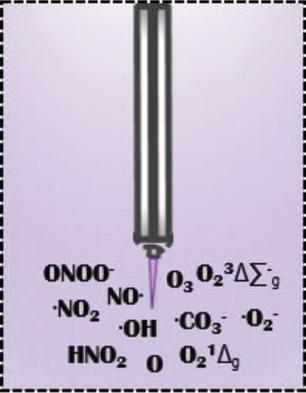Our official English website, www.x-mol.net, welcomes your feedback! (Note: you will need to create a separate account there.)
Medical Gas Plasma Jet Technology Targets Murine Melanoma in an Immunogenic Fashion.
Advanced Science ( IF 15.1 ) Pub Date : 2020-03-30 , DOI: 10.1002/advs.201903438 Sander Bekeschus 1 , Ramona Clemen 1 , Felix Nießner 1 , Sanjeev Kumar Sagwal 1 , Eric Freund 1 , Anke Schmidt 1
Advanced Science ( IF 15.1 ) Pub Date : 2020-03-30 , DOI: 10.1002/advs.201903438 Sander Bekeschus 1 , Ramona Clemen 1 , Felix Nießner 1 , Sanjeev Kumar Sagwal 1 , Eric Freund 1 , Anke Schmidt 1
Affiliation

|
Medical technologies from physics are imperative in the diagnosis and therapy of many types of diseases. In 2013, a novel cold physical plasma treatment concept was accredited for clinical therapy. This gas plasma jet technology generates large amounts of different reactive oxygen and nitrogen species (ROS). Using a melanoma model, gas plasma technology is tested as a novel anticancer agent. Plasma technology derived ROS diminish tumor growth in vitro and in vivo. Varying the feed gas mixture modifies the composition of ROS. Conditions rich in atomic oxygen correlate with killing activity and elevate intratumoral immune-infiltrates of CD8+ cytotoxic T-cells and dendritic cells. T-cells from secondary lymphoid organs of these mice stimulated with B16 melanoma cells ex vivo show higher activation levels as well. This correlates with immunogenic cancer cell death and higher calreticulin and heat-shock protein 90 expressions induced by gas plasma treatment in melanoma cells. To test the immunogenicity of gas plasma treated melanoma cells, 50% of mice vaccinated with these cells are protected from tumor growth compared to 1/6 and 5/6 mice negative control (mitomycin C) and positive control (mitoxantrone), respectively. Gas plasma jet technology is concluded to provide immunoprotection against malignant melanoma both in vitro and in vivo.
中文翻译:

医用气体等离子喷射技术以免疫原性方式针对小鼠黑色素瘤。
物理学医学技术对于多种疾病的诊断和治疗至关重要。2013年,一种新颖的冷物理等离子体治疗概念获得临床治疗认可。这种气体等离子喷射技术会产生大量不同的活性氧和氮物质 (ROS)。使用黑色素瘤模型,气体等离子体技术作为一种新型抗癌剂进行了测试。等离子体技术衍生的 ROS 可减少体外和体内肿瘤的生长。改变原料气混合物会改变 ROS 的组成。富含原子氧的条件与杀伤活性相关,并提高 CD8+ 细胞毒性 T 细胞和树突状细胞的瘤内免疫浸润。来自这些小鼠的次级淋巴器官的 T 细胞在体外用 B16 黑色素瘤细胞刺激后也显示出更高的激活水平。这与黑色素瘤细胞中气体等离子体处理诱导的免疫原性癌细胞死亡以及更高的钙网蛋白和热休克蛋白 90 表达相关。为了测试气体等离子体处理的黑色素瘤细胞的免疫原性,与阴性对照(丝裂霉素 C)和阳性对照(米托蒽醌)的小鼠分别为 1/6 和 5/6 相比,50% 的接种这些细胞的小鼠免受肿瘤生长。气体等离子体喷射技术可在体外和体内提供针对恶性黑色素瘤的免疫保护。
更新日期:2020-03-30
中文翻译:

医用气体等离子喷射技术以免疫原性方式针对小鼠黑色素瘤。
物理学医学技术对于多种疾病的诊断和治疗至关重要。2013年,一种新颖的冷物理等离子体治疗概念获得临床治疗认可。这种气体等离子喷射技术会产生大量不同的活性氧和氮物质 (ROS)。使用黑色素瘤模型,气体等离子体技术作为一种新型抗癌剂进行了测试。等离子体技术衍生的 ROS 可减少体外和体内肿瘤的生长。改变原料气混合物会改变 ROS 的组成。富含原子氧的条件与杀伤活性相关,并提高 CD8+ 细胞毒性 T 细胞和树突状细胞的瘤内免疫浸润。来自这些小鼠的次级淋巴器官的 T 细胞在体外用 B16 黑色素瘤细胞刺激后也显示出更高的激活水平。这与黑色素瘤细胞中气体等离子体处理诱导的免疫原性癌细胞死亡以及更高的钙网蛋白和热休克蛋白 90 表达相关。为了测试气体等离子体处理的黑色素瘤细胞的免疫原性,与阴性对照(丝裂霉素 C)和阳性对照(米托蒽醌)的小鼠分别为 1/6 和 5/6 相比,50% 的接种这些细胞的小鼠免受肿瘤生长。气体等离子体喷射技术可在体外和体内提供针对恶性黑色素瘤的免疫保护。

























 京公网安备 11010802027423号
京公网安备 11010802027423号